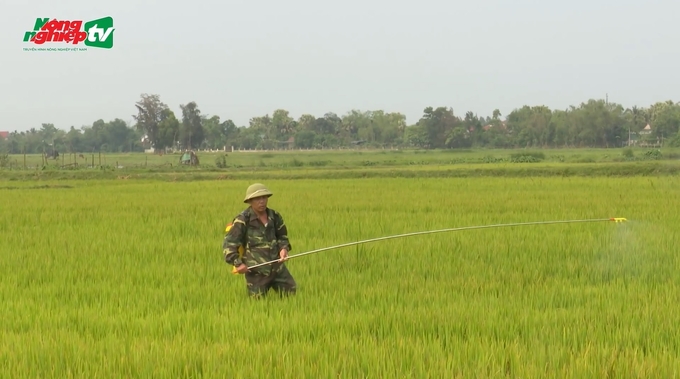May 24, 2025 | 16:29 GMT +7
May 24, 2025 | 16:29 GMT +7
Hotline: 0913.378.918
May 24, 2025 | 16:29 GMT +7
Hotline: 0913.378.918
Winter-spring rice In Northern provinces is at the growing - flowering stage, and it is also a very sensitive period for neck blast disease. Meanwhile, the weather is progressing in favor for an outbreak and strong growth of neck blast disease, so farmers in Northern provinces are having their hands full with neck blast prevention and control activities.
Mr. Phan Trong Hung has a 7-sao (0.35 ha) spring rice crop in Thach Van commune, Thach Ha district. At the beginning of March, his family’s rice field was struck by leaf blast but prevented thanks to Mr. Hung spraying fungicide in time. This rice area is now at the late growing – near flowering stage. After there is the announcement of the commune on neck blast prevention, he urgently sprayed all his 7 sao of rice.

With the alternating sunny and rainy weather situation, high humidity at the rice’s flowering stage, plus the existing source of blast disease in the field, the risk of neck blast is high, potentially affecting the productivity of the winter-spring crop.
Right after there was a telegram from the provincial People's Committee, localities examined the growth and determined the flowering time of each crop, field, area, variety to timely organize spraying for prevention. “The commune People’s Committee has provided direction and inspected to check on when the flowering time comes to direct the people on pests and diseases prevention, especially for neck blast disease. The goal is to ensure that the crop achieves the best result,” said Mr. Nguyen Viet Son, Deputy Director of Luu Vinh Son commune People’s Committee, Thach Ha district, Ha Tinh province.
According to Ha Tinh Sub-department of Crop Production and Plant Protection, it is expected that from April 15 to 20 there would be 18,500 ha of flowering rice, and from April 20 to 25 there the bloomed rice area would reach approximately 25,000 ha. Therefore it is deemed essential to deploy preventive spraying for this entire area. Among them, areas that are recently infected with leaf blast, areas frequently harmed by neck blast, and areas planting infected varieties require dual treatment.
“All the rice areas that are blooming in the weather favorable for neck blast must receive treatment. There are several directions. The first is about the spraying time. It should be done when the rice starts blooming. The second is to use fungicides that are highly effective in the area during these past times such as Filia or Beam to prevent neck blast disease,” said Mr. Nguyen Van An, Deputy Director of Center for Science and Technology Application & Plant and Livestock Protection, Thach Ha district, Ha Tinh province.

Mr. Nguyen Quy Duong, Deputy Director of Plant Protection Department, share some thoughts on the situation of winter-spring rice crop
According to Mr. Nguyen Quy Duong, Deputy Director of Plant Protection Department, currently in the Northern area, particularly the North Central region, there are approximately 350,000 ha of rice, and in the area of Northern provinces, there are over 700,000 ha of winter-spring rice. The rice seasonal crop in the North Central region is coming sooner than the Northern area. In the North Central region at the moment, rice begins to bloom, and for provinces in the area starting from Quang Binh inward, the rice area has a low risk for neck blast disease. But the present rice crop of Nghe An and Ha Tinh will bloom during the period from April 20 to April 30. These are areas with a high risk of neck blast.
Over the past time, localities have organized and given many directives in order to prevent this disease. For example, Nghe An has two directive texts. Ha Tinh also has a telegram from the Provincial People's Committee to instruct the disease prevention for the rice area that recently blooms from April 15 to April 20. However, from April 20 to April 30, the main rice crop of Nghe An and Ha Tinh will be in full bloom, and with such weather conditions as of now, there lies the risk of neck blast in these areas.
As for the Northern provinces, with over 720,000 ha of rice, the early crop is just starting to bloom a little and may fully grow from April 20 to April 30, while the main crop will fully grow from May 5 to May 20. And for this year the late crop will basically grow in full from May 20 to May 30. This means that the crops in the Northern provinces are 1 week slower than the winter-spring crop of 2021.
“These crops, especially the main crop and the late crop, require further monitoring of the weather. We have to keep a close eye on it. When the time has come for the flowering stage but the weather forecast still captures some possibilities of risk, it is a must that we keep abreast of the situation and give prevention directives for those crops,” said Mr. Nguyen Quy Duong, Deputy Director of Plant Protection Department.
Translated by Samuel Pham

(VAN) The People's Committee of Tra Vinh province has approved an adjustment to the investment policy for the Green Hydrogen Plant project, increasing its area to approximately 52.76 hectares.
![Reducing emissions from rice fields: [2] Farmers’ commitment to the soil](https://t.ex-cdn.com/nongnghiepmoitruong.vn/608w/files/news/2025/05/05/dsc08881jpg-nongnghiep-140632.jpg)
(VAN) Clean rice cultivation model in Thuong Tan commune, Bac Tan Uyen district, is assisting local residents in achieving sustainable agriculture by substantially reducing costs, increasing productivity, and protecting the environment.

(VAN) At the conference to disseminate Resolution No. 68, AgriS introduced its digital agricultural ecosystem and reaffirmed its commitment to accompanying the Government in promoting private sector development and sustainable agriculture.

(VAN) 'Blue Ocean - Blue Foods' initiative is designed to restore marine ecosystems and establish sustainable livelihoods for local communities by cultivating a minimum of 1,000 hectares of cottonii seaweed in the first three years.
/2025/05/21/4642-3-112707_603.jpg)
(VAN) The V-SCOPE project has made direct contributions to three out of six pillars of the Comprehensive Strategic Partnership between Vietnam and Australia.

(VAN) Facing the threat of rabies spreading to the community, Gia Lai province urgently carries out measures to vaccinate dogs and cats on a large scale.

(VAN) Disease-free livestock farming not only protects livestock herds but also stabilizes production and livelihoods for many farmers in Tuyen Quang.